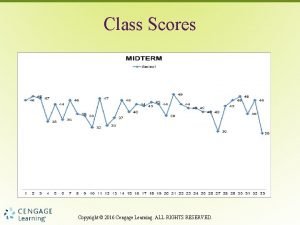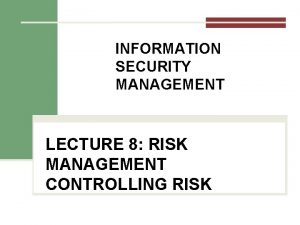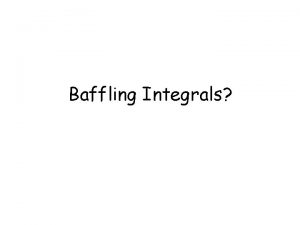15 Multiple Integrals Copyright Cengage Learning All rights
















































- Slides: 48

15 Multiple Integrals Copyright © Cengage Learning. All rights reserved.

15. 1 Double Integrals over Rectangles Copyright © Cengage Learning. All rights reserved.

Review of the Definite Integral 3

Review of the Definite Integral First let’s recall the basic facts concerning definite integrals of functions of a single variable. If f (x) is defined for a x b, we start by dividing the interval [a, b] into n subintervals [xi – 1, xi] of equal width x = (b – a)/n and we choose sample points in these subintervals. Then we form the Riemann sum and take the limit of such sums as n definite integral of f from a to b: to obtain the 4

Review of the Definite Integral In the special case where f (x) 0, the Riemann sum can be interpreted as the sum of the areas of the approximating rectangles in Figure 1, and represents the area under the curve y = f (x) from a to b. Figure 1 5

Volumes and Double Integrals 6

Volumes and Double Integrals In a similar manner we consider a function f of two variables defined on a closed rectangle R = [a, b] [c, d ] = {(x, y) | a x b, c y d } and we first suppose that f (x, y) 0. The graph of f is a surface with equation z = f (x, y). Let S be the solid that lies above R and under the graph of f, that is, S = {(x, y, z) (See Figure 2. ) Figure 2 | 0 z f (x, y), (x, y) R} 7

Volumes and Double Integrals Our goal is to find the volume of S. The first step is to divide the rectangle R into subrectangles. We accomplish this by dividing the interval [a, b] into m subintervals [xi – 1, xi] of equal width x = (b – a)/m and dividing [c, d ] into n subintervals [yj – 1, yj] of equal width y = (d – c)/n. 8

Volumes and Double Integrals By drawing lines parallel to the coordinate axes through the endpoints of these subintervals, as in Figure 3, we form the subrectangles Rij = [xi – 1, xi] [yj– 1, yj] = {(x, y) | xi – 1 x xi , yj– 1 y yj } each with area A = x y. Dividing R into subrectangles Figure 3 9

Volumes and Double Integrals If we choose a sample point in each Rij, then we can approximate the part of S that lies above each Rij by a thin rectangular box (or “column”) with base Rij and height as shown in Figure 4. The volume of this box is the height of the box times the area of the base rectangle: Figure 4 10

Volumes and Double Integrals If we follow this procedure for all the rectangles and add the volumes of the corresponding boxes, we get an approximation to the total volume of S: (See Figure 5. ) This double sum means that for each subrectangle we evaluate f at the chosen point and multiply by the area of the subrectangle, and then we add the results. Figure 5 11

Volumes and Double Integrals Our intuition tells us that the approximation given in (3) becomes better as m and n become larger and so we would expect that We use the expression in Equation 4 to define the volume of the solid S that lies under the graph of f and above the rectangle R. 12

Volumes and Double Integrals Limits of the type that appear in Equation 4 occur frequently, not just in finding volumes but in a variety of other situations even when f is not a positive function. So we make the following definition. 13

Volumes and Double Integrals The precise meaning of the limit in Definition 5 is that for every number ε > 0 there is an integer N such that for all integers m and n greater than N and for any choice of sample points in Rij. A function f is called integrable if the limit in Definition 5 exists. 14

Volumes and Double Integrals It is shown in courses on advanced calculus that all continuous functions are integrable. In fact, the double integral of f exists provided that f is “not too discontinuous. ” In particular, if f is bounded on R, [that is, there is a constant M such that | f (x, y) | M for all (x, y) in R], and f is continuous there, except on a finite number of smooth curves, then f is integrable over R. 15

Volumes and Double Integrals Dividing R into subrectangles Figure 3 The sample point can be chosen to be any point in the subrectangle Rij, but if we choose it to be the upper right-hand corner of Rij [namely (xi, yj), see Figure 3], then the expression for the double integral looks simpler: 16

Volumes and Double Integrals By comparing Definitions 4 and 5, we see that a volume can be written as a double integral: 17

Volumes and Double Integrals The sum in Definition 5, is called a double Riemann sum and is used as an approximation to the value of the double integral. [Notice how similar it is to the Riemann sum in (1) for a function of a single variable. ] 18

Volumes and Double Integrals If f happens to be a positive function, then the double Riemann sum represents the sum of volumes of columns, as in Figure 5, and is an approximation to the volume under the graph of f. Figure 5 19

Example 1 Estimate the volume of the solid that lies above the square R = [0, 2] and below the elliptic paraboloid z = 16 – x 2 – 2 y 2. Divide R into four equal squares and choose the sample point to be the upper right corner of each square Rij. Sketch the solid and the approximating rectangular boxes. 20

Example 1 – Solution The squares are shown in Figure 6 The paraboloid is the graph of f (x, y) = 16 – x 2 – 2 y 2 and the area of each square is A = 1. 21

Example 1 – Solution cont’d Approximating the volume by the Riemann sum with m = n = 2, we have = f (1, 1) A + f (1, 2) A + f (2, 1) A + f (2, 2) A = 13(1) + 7(1) + 10(1) + 4(1) = 34 22

Example 1 – Solution cont’d This is the volume of the approximating rectangular boxes shown in Figure 7 23

The Midpoint Rule 24

The Midpoint Rule The methods that we used for approximating single integrals (the Midpoint Rule, the Trapezoidal Rule, Simpson’s Rule) all have counterparts for double integrals. Here we consider only the Midpoint Rule for double integrals. This means that we use a double Riemann sum to approximate the double integral, where the sample point in Rij is chosen to be the center of Rij. In other words, is the midpoint of [xi – 1, xi] and is the midpoint of [yj – 1, yj]. 25

The Midpoint Rule 26

Example 3 Use the Midpoint Rule with m = n = 2 to estimate the value of the integral R(x – 3 y 2) d. A, where R = {(x, y) | 0 x 2 , 1 y 2}. Solution: In using the Midpoint Rule with m = n = 2, we evaluate f (x, y) = x – 3 y 2 at the centers of the four subrectangles shown in Figure 10 27

Example 3 – Solution So cont’d and The area of each subrectangle is Thus 28

Example 3 – Solution cont’d Thus we have 29

Iterated Integrals 30

Iterated Integrals Suppose that f is a function of two variables that is integrable on the rectangle R = [a, b] [c, d ]. We use the notation to mean that x is held fixed and f (x, y) is integrated with respect to y from y = c to y = d. This procedure is called partial integration with respect to y. (Notice its similarity to partial differentiation. ) Now is a number that depends on the value of x, so it defines a function of x: 31

Iterated Integrals If we now integrate the function A with respect to x from x = a to x = b, we get The integral on the right side of Equation 7 is called an iterated integral. Usually the brackets are omitted. Thus means that we first integrate with respect to y from c to d and then with respect to x from a to b. 32

Iterated Integrals Similarly, the iterated integral means that we first integrate with respect to x (holding y fixed) from x = a to x = b and then we integrate the resulting function of y with respect to y from y = c to y = d. Notice that in both Equations 8 and 9 we work from the inside out. 33

Example 4 Evaluate the iterated integrals. (a) (b) Solution: (a) Regarding x as a constant, we obtain 34

Example 4 – Solution cont’d Thus the function A in the preceding discussion is given by in this example. We now integrate this function of x from 0 to 3: 35

Example 4 – Solution cont’d (b) Here we first integrate with respect to x: 36

Iterated Integrals Notice that in Example 4 we obtained the same answer whether we integrated with respect to y or x first. In general, it turns out (see Theorem 10) that the two iterated integrals in Equations 8 and 9 are always equal; that is, the order of integration does not matter. (This is similar to Clairaut’s Theorem on the equality of the mixed partial derivatives. ) 37

Iterated Integrals The following theorem gives a practical method for evaluating a double integral by expressing it as an iterated integral (in either order). 38

Iterated Integrals In the special case where f (x, y) can be factored as the product of a function of x only and a function of y only, the double integral of f can be written in a particularly simple form. To be specific, suppose that f (x, y) = g (x)h (y) and R = [a, b] [c, d]. Then Fubini’s Theorem gives 39

Iterated Integrals In the inner integral, y is a constant, so h(y) is a constant and we can write since is a constant. Therefore, in this case, the double integral of f can be written as the product of two single integrals: 40

Average Value 41

Average Value We know that the average value of a function f of one variable defined on an interval [a, b] is In a similar fashion we define the average value of a function f of two variables defined on a rectangle R to be where A(R) is the area of R. 42

Average Value If f (x, y) 0, the equation A(R) fave = f (x, y) d. A says that the box with base R and height fave has the same volume as the solid that lies under the graph of f. [If z = f (x, y) describes a mountainous region and you chop off the tops of the mountains at height fave, then you can use them to fill in the valleys so that the region becomes completely flat. See Figure 17. ] Figure 17 43

Example 9 The contour map in Figure 18 shows the snowfall, in inches, that fell on the state of Colorado on December 20 and 21, 2006. (The state is in the shape of a rectangle that measures 388 mi west to east and 276 mi south to north. ) Use the contour map to estimate the average snowfall for the entire state of Colorado on those days. Figure 18 44

Example 9 – Solution Let’s place the origin at the southwest corner of the state. Then 0 x 388, 0 y 276, and f (x, y) is the snowfall, in inches, at a location x miles to the east and y miles to the north of the origin. If R is the rectangle that represents Colorado, then the average snowfall for the state on December 20– 21 was where A(R) = 388 276. 45

Example 9 – Solution cont’d To estimate the value of this double integral, let’s use the Midpoint Rule with m = n = 4. In other words, we divide R into 16 subrectangles of equal size, as in Figure 19 46

Example 9 – Solution cont’d The area of each subrectangle is = 6693 mi 2 Using the contour map to estimate the value of f at the center of each subrectangle, we get ≈ A[0 + 15 + 8 + 7 + 25 + 18. 5 + 11 + 4. 5 + 28 + 17 + 13. 5 + 12 + 15 + 17. 5 + 13] = (6693)(207) 47

Example 9 – Solution cont’d Therefore On December 20– 21, 2006, Colorado received an average of approximately 13 inches of snow. 48
 Cengage chapter 7
Cengage chapter 7 Change of variables multiple integrals
Change of variables multiple integrals Copyright 2015 all rights reserved
Copyright 2015 all rights reserved Copyright © 2015 all rights reserved
Copyright © 2015 all rights reserved Dell all rights reserved copyright 2009
Dell all rights reserved copyright 2009 Copyright © 2018 all rights reserved
Copyright © 2018 all rights reserved Chapter 6:2 interpreting word parts
Chapter 6:2 interpreting word parts Chapter 5 the cardiovascular system labeling exercises
Chapter 5 the cardiovascular system labeling exercises Cengage learning heart diagram
Cengage learning heart diagram South-western cengage learning
South-western cengage learning Chapter 13 medical math
Chapter 13 medical math 2009 delmar cengage learning
2009 delmar cengage learning Cengage learning heart diagram
Cengage learning heart diagram Medical terminology chapter 1 learning exercises answers
Medical terminology chapter 1 learning exercises answers Cengage learning australia
Cengage learning australia Graphing tpr
Graphing tpr Cengage learning
Cengage learning Cengage learning
Cengage learning Wadsworth cengage learning
Wadsworth cengage learning Cengage learning
Cengage learning Cengage learning plant cell
Cengage learning plant cell Cengage learning
Cengage learning Cengage learning
Cengage learning Brooks cole cengage learning
Brooks cole cengage learning Cengage learning chapter 7 answers
Cengage learning chapter 7 answers 2014 cengage learning accounting answers
2014 cengage learning accounting answers Cengage learning
Cengage learning Cengage learning
Cengage learning 2009 delmar cengage learning
2009 delmar cengage learning Cengage learning
Cengage learning 2009 delmar cengage learning
2009 delmar cengage learning Marketing implications
Marketing implications 2012 cengage learning
2012 cengage learning Solomon four group design
Solomon four group design Cengage learning psychology
Cengage learning psychology Course technology cengage learning
Course technology cengage learning Course technology cengage learning
Course technology cengage learning Course technology cengage learning
Course technology cengage learning Course technology cengage learning
Course technology cengage learning 2016 cengage learning
2016 cengage learning Delmar cengage learning instructor resources
Delmar cengage learning instructor resources 2014 cengage learning
2014 cengage learning 2010 cengage learning
2010 cengage learning Negative rights vs positive rights
Negative rights vs positive rights Difference between littoral and riparian rights
Difference between littoral and riparian rights Legal rights and moral rights
Legal rights and moral rights Legal rights and moral rights
Legal rights and moral rights What is negative right
What is negative right Negative rights
Negative rights








































































